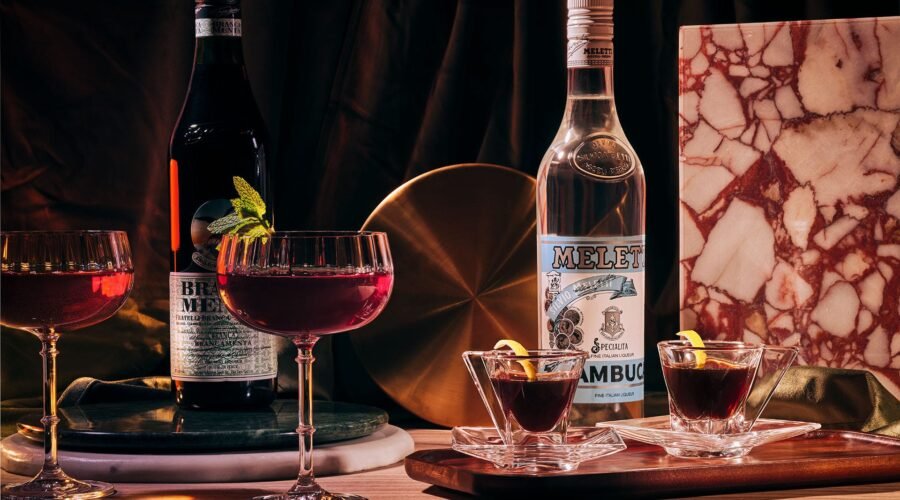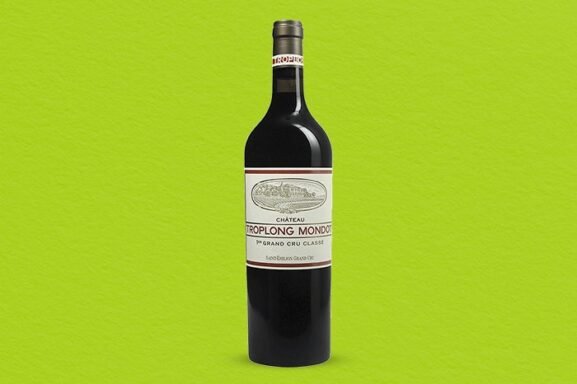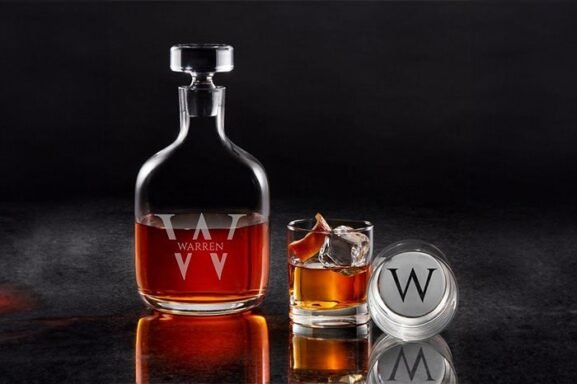Culture: A Guide to Italy’s Essential Liqueurs
From nutty nocino to anise-tinged sambuca, Italy has long enjoyed a rich collection of liqueurs, turning local ingredients into pleasing after-dinner sips. “Italians like to be at the table for as long as possible after the meal, enjoying an espresso or a digestivo,” explains Sabato Sagaria, who pours plenty of both at New York City Italian restaurant One Fifth. “It’s part of Italian dining culture.”
Yet, outside of Italy, it can be a little confusing to decipher what’s in those many storied bottles or how to serve them. Here’s our cheat sheet. While they can be easily enjoyed on their own, Italy’s liqueurs also are versatile components for cocktails, so you’ll find super-simple drinks suggestions, too.
Winding down a meal with one of these liqueurs reveals much about the Italian approach to life, notes Shannon Fagan, assistant general manager at Vetri Cucina in Las Vegas: “Feast with an Italian, and you’ll learn that they’ve figured out the secret to really enjoying life.” So, slow down and linger over some liqueurs with us.
Maraschino
Region: Veneto
What it is: To understand maraschino, made from sour marasca cherries, it helps to know that Croatia—where these cherries grow in abundance, just across the Adriatic Sea—was previously part of Italy. It’s a confusing liqueur—intense rather than strictly sweet, and not tasting much like cherries, since it’s distilled from the fruit (and pits and leaves) rather than infused with it, which yields a more neutral flavor. “Though it may be enjoyed straight as a digestivo,” notes Reno De Ranieri, co-owner of Osteria Lupo in New Orleans, more often “the liqueur finds its way on to our menu as a crucial ingredient in a number of classic cocktails,” from the Hemingway Daiquiri to the Last Word.
Pour It
This clear liqueur is bracing and lightly sweet.

Luxardo Maraschino
The bouquet is lovely, balanced, properly astringent, ripe and juicy with scents of cherry stone and cherry juice. The palate entry is decadently sweet and textured with vibrant tastes of cherry compote and cherry preserves at midpalate. The finish is svelte, moderately syrupy and downright delicious. An outstanding liqueur: use it in an Aviation Cocktail. 90-95 Points.
$40
Total Wine & More
More Options:
Mix It
Last Word
Shake equal parts maraschino liqueur, gin, Green Chartreuse and lime juice with ice, then strain into a coupe glass. Garnish with a brandied cherry.
Amaretto
Region: Lombardy
What it is: Though the flavor is redolent of almond, the actual agent is apricot pits, which are often combined with sugar and essential oils, says Sagaria, who shares this story: According to legend, in 1525, Bernardino Luini, a student of famed artist Leonardo da Vinci, was commissioned to paint a fresco of the Madonna of the Miracles in Saronno. The young woman selected to model for the image thanked Luini with a flask of homemade amaretto. Today, the liqueur is often mixed into drinks like the amaretto sour. “It’s fun to play with in cocktails,” says Sagaria, “or pour it over ice cream at the end of a meal.”
Pour It
Sweet, almond cookie-like flavor accented with vanilla and orange.

Disaronno Originale
Many will recognize the square dimpled bottle on the back bar right away. The amber liquid inside the bottle is distinctive too, with its sweet amaretto-cookie aroma and thin, almond extract flavor, touched with vanilla and orange. It’s a classic for amaretto sours or lacing coffee. 87 Points —Kara Newman
$28
Total Wine & More
More Options:
Mix It
The Godfather
Stir 1 1/2 ounces each Amaretto and Scotch over ice. Garnish with an orange peel or add a couple of dashes of Angostura bitters.
Nocino
Region: Emilia-Romagna
What it is: “Not to be confused with its sweeter cousin nocello, nocino is a more bitter digestivo made from not-fully-ripened green walnuts,” De Ranieri explains. Of note, nocino also has ties to when the Roman Empire converted to Christianity under Emperor Constantine. Traditionally, the green walnuts are harvested on June 24th (St. John’s Day, celebrating John the Baptist), then infused in a neutral spirit for several months and consumed throughout the holiday season. In addition to Italian-made versions, a growing number of American distilleries make nocino using local green walnuts. While the liqueur is an easy sipper neat or over ice, its richness pairs beautifully with dark spirits.
Pour It
Herbaceous and nutty, accented with plenty of baking spice.

Vicario Nocino Walnut Liqueur
Dark, inky brown, with a savory, herbaceous scent. The flavor surprises with a spicy burst up front, with leads to cola, amaro-like bitterness, and a rounded, mouthwatering finish accented with vanilla, clove and allspice. There’s a pronounced alcohol kick; seems ideal as a warming post-prandial sipper. 91 Points —K.N.
$50
Wine.com
More Options:
Mix It
Black Walnut Manhattan
Stir 2 ounces rye whiskey, 1 part Averna amaro and 1/2 ounce nocino with ice, then strain into a coupe glass.

Fernet
Region: Milan
What it is: While Fernet-Branca is a household name, it’s just one brand among the fernet subcategory. Typically, it’s dark hued and bittersweet (often more aggressively bitter than sweet), flavored with an array of botanicals and bittering agents. “Branca is made with 27 different botanicals,” including gentian root, chamomile, rhubarb, bitter orange and saffron, Sagaria says. However, minty Branca Menta is his pick, popularized by opera singer Maria Callas, who claimed the peppermint-infused bitter over crushed ice helped her performance. In addition to Italian-made fernets, keep an eye out for the growing range of American-made versions.
Pour It
The mintier, milder version of super-bitter Fernet-Branca.

Branca Menta
With a concentrated spearmint aroma, this liqueur has a chocolaty core and plenty of cooling mint, like a mint-chocolate cookie with a moderately bitter edge. Use to sass up a classic Grasshopper or other drinks that call for crème de cacao. 92 Points —K.N.
$37
Total Wine & More
Stateside Options:
Mix It
Branca Menta Shakerato
In a cocktail shaker, combine 3 ounces Branca Menta with plenty of ice. Shake well, then strain into a coupe glass.
Sambuca
Region: Rome/Le Marche (Central Italy)
What it is: Sambuca is a clear liqueur made specifically from star anise and green aniseed and tends to have a relatively high sugar content (by comparison, anisette includes a wider range of anise liqueurs, and tends to be less sweet). It may be made with other flavorings, too, such as fennel, citrus peel or cinnamon. Think of Rome’s history as a port city—with ships bringing in spices and exotic ingredients from around the world—as the gateway to sambuca’s licoricelike flavoring. While caffè corretto (espresso “corrected” with sambuca) is a classic serve, “my favorite is a shot with one coffee bean, called ‘con la mosca’—with the fly,” Fagan says. “The aromatics of that single bean and the anise make me smile every time I take a sip.”
Pour It
Expect a mild, candy-like black licorice flavor.

Meletti Sambuca
Look for a mild licorice aroma with a hint of espresso. Each sip is palate-coating and relatively sweet, reminiscent of Good and Plenty licorice candies, finishing with an assertive hint of spice and alcohol heat that cuts through the sweetness. An easy-sipping dessert pour. 90 Points —K.N.
$22
Total Wine & More
More Options:
Mix It
Caffè Corretto
Pour 1/2 ounce sambuca into a shot of espresso. Make it cold (and less traditional): stir 1/2 ounce sambuca with 2 ounces cold-brew coffee, 1 ounce cream, and ice; garnish with orange peel.
This article originally appeared in the August/September 2023 issue of Wine Enthusiast magazine. Click here to subscribe today!
Published: September 1, 2023
Like what you’re reading? Learn more about:


